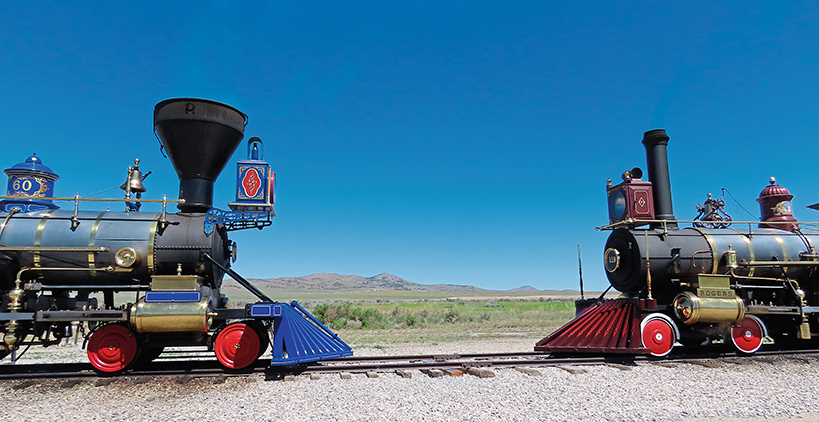The historic site of America’s first transcontinental railroad visited
Posted by Chris Graham on 8th May 2023
Kevin Hoggett visits The Golden Spike National Historic Park, where two railways met to create America’s first transcontinental railroad.

America’s first transcontinental railroad: Jupiter – No. 60 gets up steam prior to the re-enactment.
About one-and-a-half hour’s drive north from Salt Lake City, a 30-mile detour from the main road brings one to the remote Promontory Summit. It’s here that on May 10th, 1869, a ceremony took place linking the Union Pacific and Central Pacific Railroads to form the first transcontinental American railroad. Two locomotives met and a golden rail spike was ceremoniously hammered into the track between them. The two locomotive engineers (drivers) then broke champagne bottles over each other’s engines, and the whole occasion was recorded by contemporary photographers.

No. 119 does a demonstration run on the re-laid track, proving she’s a coal burner!. The remoteness of the site can be clearly seen.
Today, the transcontinental railroad no longer passes this spot, but the location has been designated as The Golden Spike National Historic Park. There’s a visitor centre and about a mile of track has been relaid there. Further, in 1979, two beautiful, full-size replicas of the original locomotives involved were constructed and these are steamed for visitors on most days during the summer months.
The locos in question are Central Pacific 4-4-0 wood-burner No. 60, Jupiter, originally built in September 1868 by the Schenectady Locomotive Works in New York State, and scrapped in 1909; and Union Pacific 4-4-0 coal-burner No. 119, constructed in November 1868 by Rogers, and scrapped in 1903. The two replicas were both built by O’Connor Engineering Laboratories. Unfortunately, no drawings existed, so the firm had to rely on old photographs as well as the examination of other contemporary locos.

The traditional photograph of the two locos as they would have been in May, 1869 – but, on that occasion they would have been surrounded by very many officials, railwaymen and spectators. (All pics: Rika Laporte)
Originally, the replica locos were oil-fired but, more recently and for the sake of authenticity, they have been modified to burn their original fuels. The replicas have been built are to a very high standard, and it’s a joy to be able to step back in time and see them in albeit somewhat limited action.
This feature comes from the latest issue of Old Glory, and you can get a money-saving subscription to this magazine simply by clicking HERE





